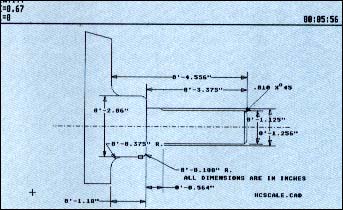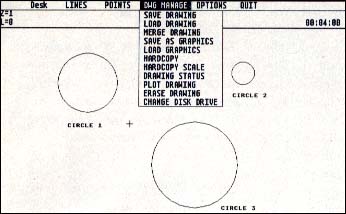Review
BetaCAD
BY DAVE EDWARDS
With all of the fuss over graphics interfaces, it would seem that they're the panacea for all our computing woes: just point and click and all your software concerns are vanquished. This being the case, it always surprises me when I see "Tips and Hints" for many programs advocating the use of keyboard equivalents to select commands instead of icons or menus.
 |
| With BetaCAD, it's very easy to draw very accurate objects with very little effort. You may occasional wish for other commands not includ- ed in BetaCAD, but you should almost always be able to create the objects you need. |
In the old days of computing, we would always use two hands, but now it seems that computers have become "one-hand bandits." In the CAD area, there's a constant debate over speed and ease of use, as if the two subjects were mutually exclusive. BetaCAD is a new low-end CAD program that does a wonderful job of bridging this seeming barrier.
Enter BetaCAD
BetaCAD is a unique program in many ways and at first threw this old CAD pro for a loop. I have become used to seeing CAD software that always seems to run in the same way. This program takes a completely different approach to CAD--and a very refreshing one. Many of the "normal" CAD commands were missing, but it wasn't until after I had had several phone conversations with the author did I discover the real beauty of BetaCAD. His contention is that you really only need a few commands to get the job done and that the problem with most CAD programs is the sheer number of commands that do exactly the same thing in slightly different ways.
I wholeheartedly agree. It was nice to see a CAD program not designed as if it has to compete feature for feature with every other program. This streamlined approached makes BetaCAD very easy to learn; the end result is that your drawings are done in very short order.
The commands are chosen by holding down the left, right or both mouse buttons and selecting a letter on the keyboard. The commands are referenced by their letter and button combination, i.e., L2 for "L" and the right mouse button. This method keeps both hands going and makes for very fast drafting. A complete list of commands is included with the program so that learning these combinations comes very quickly. The commands can also be accessed through pop-up menus, but the menus stay nicely out of the way until you need them.
As far as command selection, BetaCAD had just about every construction command you'll every need--and a few surprises. Commands use two different modes of operation, either point or entity. Point mode uses "points" for all of its functions and entity mode uses complete objects. To place most objects, you'll locate points that will define the object. There are a variety of ways to place points separately or they can be created at key locations on objects (i.e., the endpoints of lines). I found it very easy to draw very accurate objects with very little effort. At times, I did find that I wanted to use other commands not included in BetaCAD, but I always found a way to create the objects I needed.
Standard Commands Plus
BetaCAD has all the standard commands such as lines, points, arcs, circles and so on. Construction options include trimming, scaling, rotation, etc. The really unique thing about BetaCAD was the number of commands used to change existing elements. For example, after placing a line you can change its angle or length. You can alter dimensions by just dragging the endpoints to new locations. Other commands include spline, angular dimensions and shrinkage.
What is shrinkage used for? BetaCAD is one of the few programs written specifically for mechanical design (although any kind of CAD can be done with it). The shrinkage command is great for engineers doing designs to be molded in plastic or metal. Shrinkage is always a factor in these designs and now there's finally a CAD program that makes it easy to insure parts are the correct size. In other programs, you have to scale parts by a factor and then rescale them using the reciprocal. BetaCAD does all the calculations for you.
One of the hottest features of BetaCAD is the "BetaBar." This is a bar that shows up whenever a key input is needed. You can enter numbers without hunting for them on the keyboard, but more than that, the BetaBar stores various values used in the drawing and lets them be called up again. For example, say that you've just drawn a box and that now you need a line the same length as one of the sides. Instead of inquiring as to the line's length, you can "load" the BetaBar by selecting the points on the screen; now, this value is available when placing the new line or even when dimensioning.
Another feature that should get rave reviews is BetaCAD's ability to create side views of an object. Points can be placed projected from one view onto another section of your drawing. This gives you a simple and accurate way to define the objects in another view of your project.
I really enjoyed BetaCAD because it had all the "power" features of the more expensive programs, but left out many redundant commands that can just get in the way. Many commands were a total surprise for a program of this level. You can really tell that a great deal of time went into determining just which commands were needed. The user interface, although not as fancy as, say, DynaCAD, showed much thought and should make an experienced user very fast indeed.
 |
| BetaCAD commands are chosen by holding down the left, right or both mouse buttons and selecting a letter on the keyboard. This method keeps both hands going and makes for very fast drafting. |
Hard Copy Output and the Manual Output from BetaCAD is done mostly to dot-matrix printers and the program does a good job of printing. The image can be printed based upon standard sheet sizes or by setting a drawing's scale. This program is designed for the very low-end user, so support for laser printers is neither provided nor deemed necessary. There are, however, plotter drivers available for Hewlett-Packard and Zericon plotters. The choice of supporting the Zericons is a good move, because they are some of the least expensive plotters available. Once again, streamlined is the code word for output.
One of the things I would like to see changed about BetaCAD is the manual. Even though I did get an updated version while I was reviewing the program, I felt it could have been better organized for the beginning user. The overview in the front is good, but then it goes immediately to a command reference section listing all of the commands and finishes up with a tutorial. I would rather have seen each command demonstrated in a tutorial and new commands discussed as the tutorial progressed. A big plus for BetaCAD is that every command in the program has an example given --and a file. This makes it easy to learn each command. I only wish the commands were in a different order.
Additionally, since nobody designs in isolation, it would be nice to have a translator to DXF (Auto CAD format). It would also have been nice if BetaCAD had provided a file format document, so that you could easily write programs to create files to input into the ASCII BetaCAD database.
Conclusion
This is the way I like to see programmers write: get in and get out! Nobody wants to be a slave to a CAD system. CAD should be used as a tool to "hard line" a product design, not to produce the final product. BetaCAD does a great job of giving the user just the commands needed with out getting in the way of the design process. BetaCAD should be commended for taking such a noble stand. This is a great program for quick and easy CAD design and is highly recommended, especially for engineers. By the way, BetaCAD was written entirely in GFA BASIC which really surprised me--for a program of this power, you'd think it would have been written in C.
Surprise, surprise!
Dave Edwards is START's resident CAD expert. He is also a MIDI consultant, professional drummer and managing editor of "The MIDI Insider, The MIDI Power User's Newsource."
PRODUCTS MENTIONED
Beta-CAD, $99.00. BetaCAD, 31 Millard Road, North Attleboro, MA 02760, (508) 695-9175.